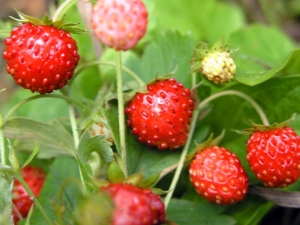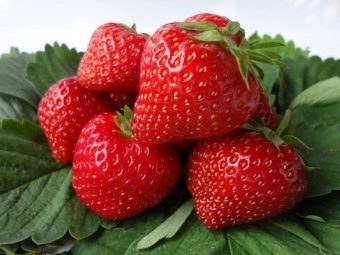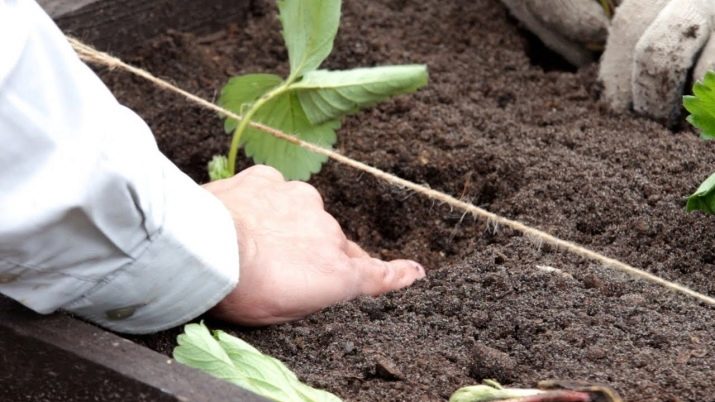Subtleties growing garden strawberries

Garden strawberries are quite popular berries, which are successfully cultivated in different climatic conditions in open ground, as well as in greenhouses and on balconies. However, in order for the plant to bear fruit regularly, it is necessary to study in detail the subtleties of the growing process and the subsequent care of the berry crop.
Variety selection
Good fruiting strawberries largely depends on the proper selection of varieties of horticultural crops. Knowing the information about the intricacies of growing one plant or another, you can avoid the development of diseases and low yields. However, there are a huge number of varieties of garden strawberries today, so it is important to determine the desired dates for ripening berries, since the main classification of a berry is based on this criterion.
There are four types of culture:
- early;
- mid-season strawberry;
- late;
- remontant.
Experienced gardeners recommend planting the best varieties of all the species in the garden to ensure a stable crop of healthy berries. In addition, attention should be paid to such characteristics of the plant as immunity to disease, fruit taste, frost resistance and yield.
The most popular varieties of strawberries are presented below.
- "Kokinskaya Early." Frost-resistant variety that bears dark-red berries. It is distinguished by an early period of ripening strawberries and excellent yield.
- "Elvira". On the bushes ripen fairly large berries. Among the characteristics of the variety is the resistance to fungal diseases.
- "Heneoye." Frost-resistant plant, which belongs to the early varieties of ripening berries, the culture has a stable immunity to many diseases.
- "Lord." Medium early self-pollinating culture that is immune to gray rot. The berries ripen large, in addition, the plant does not have a tendency to reduce the size of the berries during fruiting.
- Cambridge Favorite. It is distinguished by high taste characteristics of strawberries. The plant is resistant to fungal diseases and high yield.
- "Borovitskaya." Frost-resistant plant, which gives large berries. The culture is self-fertile, has immunity to diseases.
- "Vicoda". The variety that occupies a leading position among the frost-resistant crops. Shrubs bear large berries, the plant does not suffer from mottling and various types of rot.
- "Wima Xima." Popular due to simple farming, because it forms a mustache in a minimum quantity. The culture gives good and stable yields of berries. The taste of the fruit is commendable.
- "Crimean Remontant". It is considered one of the best crops among remontant varieties of garden strawberries. Has the ability to fruiting before the arrival of the first frost, the berries are not prone to grinding.
- "Queen Elizabeth II". On the bushes ripen large and fragrant berries. Culture is very popular among gardeners due to the mass of positive qualities.
- "A pineapple". A culture that is resistant to certain diseases, ripe berries of medium size, are colored orange.
Site selection and soil preparation
The technology of cultivation of strawberries is not difficult, however, to grow a healthy culture can only be subject to all the nuances of agricultural technology. The result will largely depend on the choice of place in the garden for planting plants.
As the practice of cultivation of the berry crop in the open field shows, the plant shows the best results on fruiting on flat terrain or gentle slopes. Should prefer the southern or western side.From planting in the lowlands should be abandoned, because the culture is likely to start to hurt, as a result - the yield will decrease. Plot for berry plantations should be reliably protected from the wind.
There are also a number of recommendations regarding soil selection.
- If you plan to breed cultivars of strawberries, it will be right to plant the plants in the soil with a neutral level of acidity. Best of all culture will develop in loam.
- Dutch and high-yielding varieties prefer light forest soils rich in humus.
- Groundwater level is extremely important. The optimal distance is considered to be their distance from the surface of 50-60 centimeters.
- Hydrogen indicator should be at the level of 4-5 units.
- The best predecessors of garden strawberries are garlic, peas, greens, carrots. Cucumbers and crucifers will become undesirable next to the strawberries, therefore, it is worth refraining from planting berries after these plants.
The scheme for preparing the ridges for planting strawberries includes the cleaning of weeds, the fertilizer of the soil with humus, as well as a complex consisting of superphosphate, potash salt and ammonium nitrate.
Landing
There are no strict prohibitions concerning the period of planting strawberries, however, rooting of plants in the fall or in the last weeks of the summer or in early spring demonstrates positive results.
When planting a crop on the garden plot in August-September, one can be sure that the plant will have time to adapt and take root in the garden before the first temperature drops.
As for the areas where air temperature fluctuations are often observed, and winters cannot boast with abundant snow, it is better to postpone the landing for the spring months.
Spring planting involves the preparation of soil in the fall. As compulsory work is cleaning and the introduction of organic fertilizers. Mineral compounds will need to be added to the soil with the arrival of spring.
Seating bushes on ridges involves placing plants at a distance of 25-30 centimeters from each other, with a step width between rows of up to one meter. Rooting wells must be at least 20 centimeters in diameter, with a depth of about 30 centimeters.
Before deepening the bush, water is introduced into the well, and then the plant is lowered and covered with earth. The root neck of strawberries should be located above the ground level. After planting, it is necessary to loosen the soil between the rows.
Under the autumn planting the soil is prepared for 10-14 days. Fertilizing works will be the same as in spring. Only all the necessary nutrients must be entered into the soil in the complex. After planting the bushes in the fall, they will need a shelter with a layer of mulch, it is best to choose straw or manure to protect the young root system from freezing. Good results are demonstrated by Finnish strawberry cultivation technology, which is widely used in Siberia and the Urals.
Non-woven material helps to protect the plant from the development of many ailments, weed multiplication and freezing.
Care
Agrotechnology after rooting strawberry bushes on the ridges suggests the following activities:
- weeding;
- hilling of beds;
- watering plants;
- the introduction of fertilizers;
- prevention of diseases and pests;
- trimming bushes;
- preparing strawberries for winter.
Weed removal is carried out as needed, the soil requires loosening after watering, since a crust forms on it, which will become an obstacle to productive air exchange. To care for the crop, you can also avoid the above works, if you cover the beds with a layer of mulch or cultivate strawberries under the agrofiber. For mulching, you can use peat, sawdust, reed.
As practice shows, strawberry plantings require transplantation, every 3-5 years, depending on the variety, the plants must be rooted elsewhere in the garden to avoid depletion of the soil and the development of some ailments.
The flowering phase falls on the 20-30 day of growing season. Sometimes the flowering process lasts about three weeks. During this period, you should monitor the soil moisture, water as needed.
In hot weather, the bushes will have to moisten quite often, because the culture is very demanding of moisture. The best way to hydrate will be artificial sprinkling. Some gardeners form furrows between the rows, into which fluids are introduced, after which they are sealed and the soil is loosened to retain moisture.
If a watering can is used for work, it is better to inject liquid directly under the root, avoiding contact with the green mass. The water temperature should be similar to the air temperature at the moment. Frequent watering will adversely affect the yield, so it is important to control the level of soil moisture. As a rule, watering strawberries need every seven days. During the pouring of fruit, the frequency of watering is reduced.
High yields of berries can be ensured timely feeding nutrients and microelements. In the role of organic compounds, you can use ash or bird droppings. Initial introduction of the formulations will be required at the beginning of the season in the growth phase, and complex preparations should opt.
The second feed is performed in the phase of formation of peduncles. In the course of flowering, mullein is introduced, and in the period when the flower buds are laid, the culture will need complexes in which there will be no nitrogen activating the growth of the bushes and the buildup of green mass.
Fertilizers are introduced only in wet soil. Remontant varieties require more frequent feeding, as they bear fruit several times a season and are very depleted.
It is necessary to transplant strawberries at least once every 5 years, repair plants grow roots in different parts of the garden every two years. The transplant technology is similar to the standard planting of crops in open ground.
After harvesting the leaves of the bushes grow and the formation of a mustache. In addition, the culture accumulates strength and nutrients for fruiting in the next season and future wintering. Therefore, it is important to provide the berries with the most comfortable conditions, including food and microclimate.
As for pruning strawberries, the views of gardeners are rather ambiguous, because the foliage is the source of nourishment for the bushes, therefore the strength of the crop depends on its quantity, besides, without the green mass, the strawberries cannot survive the cold. On the other hand, the rosettes and mustaches rob the plant of strength after fruiting, when the culture forms new buds. But since the garden strawberry is still a perennial plant, and is able to regularly update the green mass, pruning is still recommended for better growth and development of the berries.
Firstly, should be cut off the foliage that grows closest to the ground, because in this area pests overwinter most often and dangerous microorganisms accumulate. From cutting young bushes should be temporarily abandoned, because these activities can weaken the immature plant. After removing the foliage and mustache, strawberries will need preventive treatment with fungicides.
In regions with a harsh climate for the winter, strawberries should be covered with a layer of mulch. To do this, use fallen leaves or manure and straw.
Diseases and pests
In order to harvest a good harvest of strawberries it is also worth taking care of protecting the plant from various diseases and pests. It is possible to distinguish the main diseases from which the garden culture suffers.
Breeding methods
Almost all varieties of strawberries can be propagated by a mustache; as for bezusyh cultures, they are removed by breeding seeds or dividing the mother bush.
Rosettes grow in the bushes after the completion of fruiting. During this period, the soil is loosened and watered. The closest to the culture of the mustache is selected, which sinks to the ground and is powdered. After the appearance of the roots, the whiskers are separated and rooted in a permanent place on the garden bed. In some cases, the sockets are separated immediately and grown under special conditions until the roots appear.
If the option is chosen when garden strawberries are propagated by seed, you should be prepared for the fact that it will take more time. Sowing of seeds takes place in spring in specially prepared compost. Next, the seed containers are covered with soil and covered with film or glass, after which they are sent to the refrigerator for three days. After hardening, the seedlings should be in a warm place until the first shoots appear. After the appearance of three or four leaves, the plants are seated in separate containers, you can tie them up, and in May, the culture can already be rooted on the site.
Breeding by dividing the maternal bush is performed at the beginning of the season or after harvesting. To do this, the most developed plants are selected at the site, they are dug out of the ground and carry out the process of division. Culture should be planted in such a way that each plant has a horn and a good root system, in addition, strawberries must have at least three leaves.
Fusarium and verticillous wilting
These fungal infections have a detrimental effect on the root system and the aboveground part of the bushes. As a result of the lesion, the culture dries up, the disease develops quite rapidly, due to which one can lose most of the strawberry plantings. Weed cultures can provoke the disease or the soil itself on the site where the virus spores could persist. For the prevention and treatment of strawberries, it is recommended to use "Fundazolone" and "Benorad", to remove weeds in time, to use mulching and a drip irrigation system.
Late blight
The plant first affects the lower foliage, after which the disease spreads to the root system.
The fungus can be in the soil or in the acquired material for planting.
For the prevention of the disease, it is worthwhile to resort to treating the soil with trichoderma, adhere to the rules of crop rotation and remove crops from the site when the slightest signs of disease are detected. Treatment of plants is carried out by "Ridomil".
Gray rot
The most common disease that affects garden plantings. The disease spreads on thickened berry plantations. To prevent the damage of strawberries, the garden is sprayed with Euparine or Topsin-M formulations.
In addition to diseases, insects can cause damage to crops, for which fruits and plants are also of interest. Weevil is dangerous for strawberries, which overwinter in fallen leaves and soil in the garden. With the arrival of spring, he destroys the foliage on the bushes and lays eggs there. To combat the pest use "karbofos" or "Confidor". As a preventive measure, one should remove the whole carrion and fallen leaves from the site and loosen the soil between the rows of strawberries.
Strawberry mite is also a pest for strawberries: as a result of insect breeding, the curliness of the leaves appears on the bushes, the fruits become small. To prevent insect multiplication, it is necessary to treat the plants with colloidal sulfur or Neoron.
To combat the nematode near the strawberries, you can plant a calendula. For prevention, the acquired planting material is disinfected by immersing the roots for 10-15 minutes in the brine.
Regular preventive treatment of soil and plants will help to avoid the development of diseases and the multiplication of insect pests on the site.Good results are demonstrated by the treatment of bushes in the spring with copper-containing compounds, Bordeaux liquid, from insects using "Quadris" or "Envidor".
You will learn about the beneficial properties of strawberries in the following video.













































